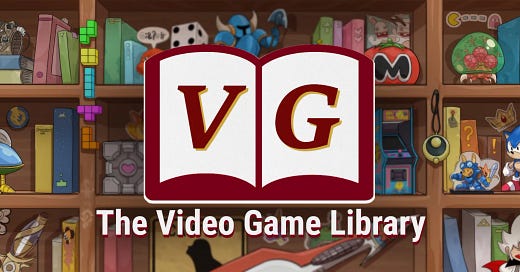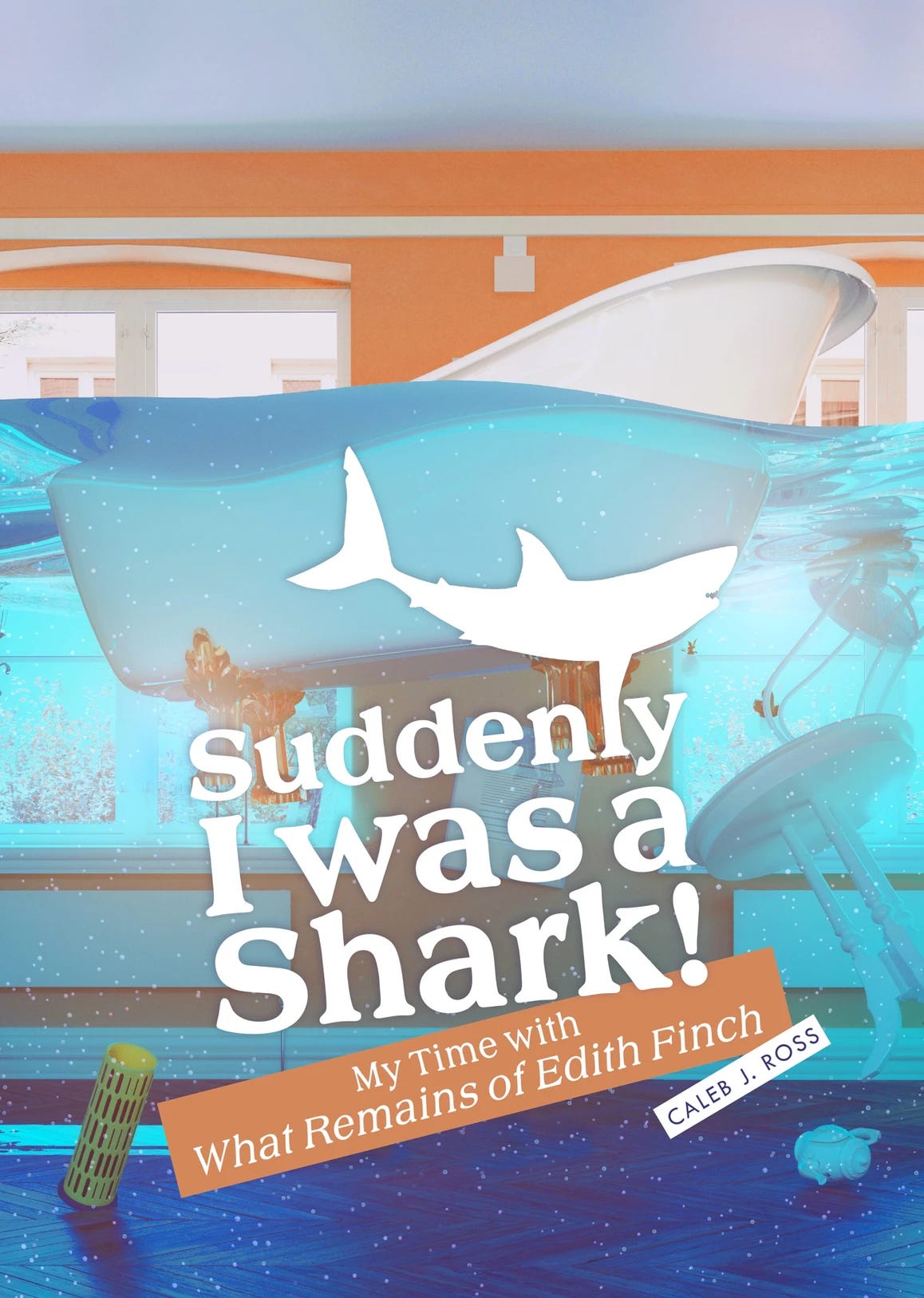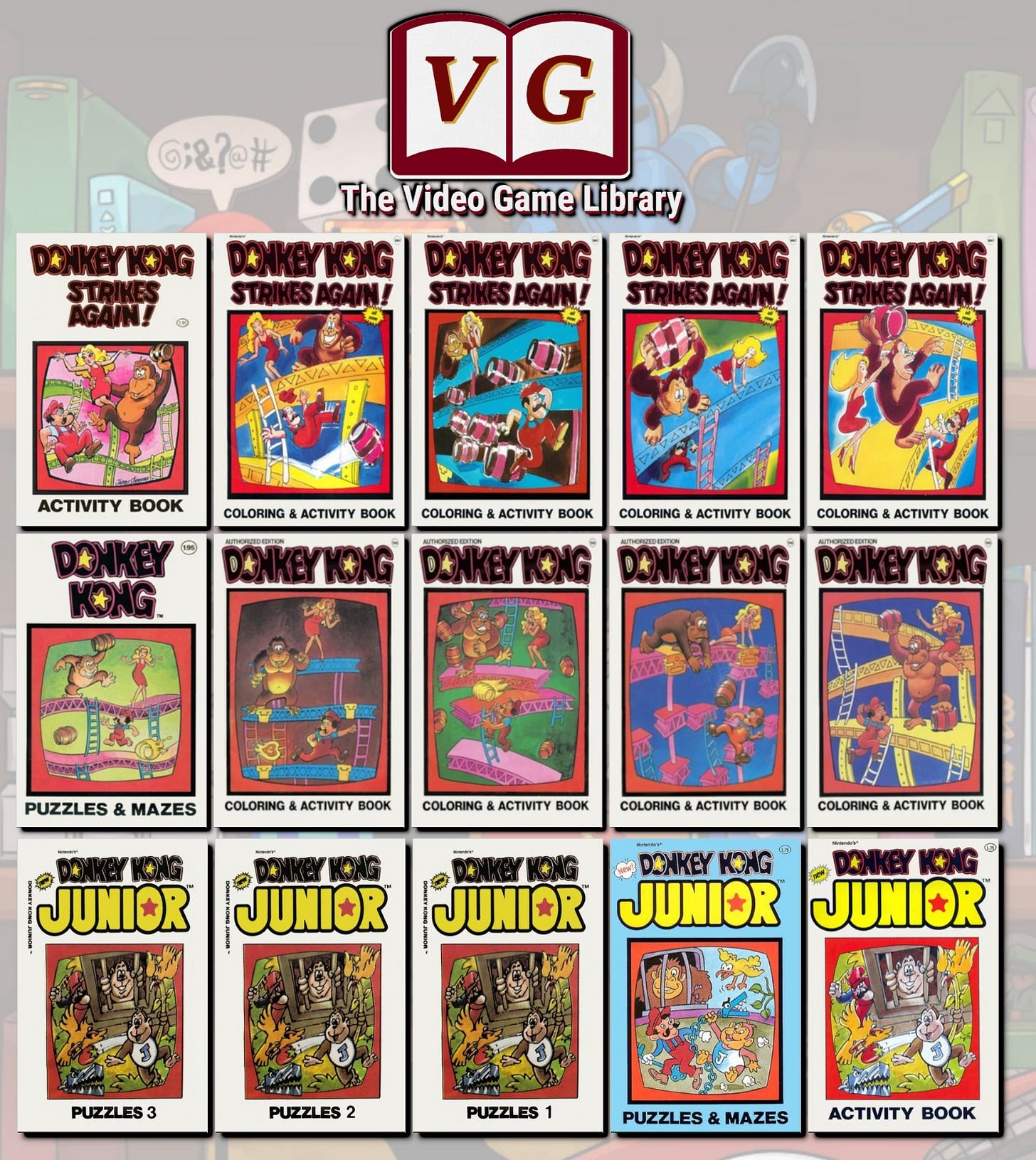The Video Game Library Newsletter - Vol. #005
Shinkigensha guides, RPG book news galore, and an amazing read on What Remains of Edith Finch. Plus an interview about Game Writing with Alex Epstein.
Welcome back to The Video Game Library Newsletter!
I hope your week has been filled with great games, good reads, and maybe even a little time to tackle that growing backlog (no judgment — we’ve all got one!).
This week's edition is packed, as usual — not only with some incredible new releases and announcements, but also a few changes based on your awesome feedback.
From the new wave of Ys VIII books hitting shelves and Final Fantasy lore goodness, to a fun bit of Donkey Kong history and a can't-miss interview with game writing expert Alex Epstein, there’s a little something here for every video game literature fan.
So grab your favorite cozy drink, settle in, and let's dive into this week in video game books and beyond!
Let’s get into it!
📰 News & Highlights
Whoa, whoa, whoa! What happened to “Behind the Shelves”!?
Don’t worry! It’s still here. But some amazing reader feedback suggested it be moved to AFTER the News & Highlights section, as to not spoil any of the exciting announcements.
So, with all of the surprises unspoiled - let’s dive in to THIS WEEK in Video Game Literature!
Perhaps one of the most exciting announcements from this week came from Dragonwell Publishing with their Ys VIII: Lacrimosa of Dana news. Starting off, the Lacrimosa of Dana Novelization is getting an full-sound Audiobook narrated by the critically acclaimed voice actors Luke R. Francis, Genevieve Swallow, and Ys VIII original cast member Kira Buckland. Then, we’re getting Castaway Tales, an anthology of spin-off stories based on all the most prominent side-quests from the game. And last, but not least, a Lacrisoma of Dana - Castaway Cookbook with recipes compiled by Miralda, the Castaway Village cook. And if ALL of these sound good, then you’re in luck, because a Collector’s Set is available, but is limited to 400 copies worldwide.
Final Fantasy Union's upcoming book, Guardians of the Crystal – An Encyclopedia of Summons, launches its Kickstarter campaign on April 28, 2025, at 7:30 PM BST. This comprehensive book sets out to explore the lore of summons across the Final Fantasy series. And there’s 3 great covers to choose from!
Coinciding with the film's theatrical debut earlier this month, Insight Editions has just released A Minecraft Movie: From Block to Big Screen, offering fans an in-depth look at the making of the live-action adaptation. The book features concept art, behind-the-scenes photography, and commentary from the filmmakers.
Dark Horse has released the English localization of The Art of Bravely Default II: 201X–2021 this week. It’s a 304-page hardcover art book showcasing character designs, landscapes, and developer commentary from the game.
Dark Horse also unveiled the Starfield Visual Compendium this week, a 192-page hardcover exploring the art and design of Bethesda's Starfield. The book is set to release on September 16, 2025, and is available for preorder.
Serenity Forge announced that The Art of Long Gone Days is now available. This 72-page art book features concept and production art from the indie game, offering fans a visual journey through its development.
And the final English announcement comes from none other than Mike Diver, who has announced Aliens: The Video Games - an unofficial guide to the entire roster of Alien video games. Old and new, licensed and unofficial, crossovers, fan projects, unreleased titles and more!
Third Editions has officially released Le grand oeuvre de FromSoftware: Le Monument Elden Ring, an in-depth analysis of the acclaimed game, authored by Sylvain Romieu.
While we saw Bloodborne: The Bleak Dominion release for English readers back in 2024, Norma Editorial has released the Spanish localization of this sixth installment of the Bloodborne comic series, titled EL REINO LÓBREGO.
Also for Spanish (and Italian) readers, the next entry in the weekly Videojuegos Legendarios series released this week - Beat Saber: La Revolución de la Realidad Virtual. This is officially the first dedicated Beat Saber book to grace the site.
SNK has published the Fatal Fury: City of the Wolves Official Setting + Artwork Collection, providing detailed setting materials, character profiles, and development insights from the series. The 256-page artbook is a must-have for fans of the franchise
Did I miss something cool? Want to see this laid out differently?
Drop it in the comments or swing by our Discord to share it with the community. Let’s keep this celebration of game-inspired books going strong!
📚 Behind the Shelves
Every week, I take you behind the scenes of The Video Game Library—highlighting the cataloging challenges, unexpected discoveries, and curiosities that pop up as we dive deeper into this ever-growing project. Here's a look at what’s been happening behind the shelves this week:
While a lot of this week was spent cataloguing alternate-language editions of older posts, the new announcements kept me on my toes. Here’s a few that just got added.
My other focus this week was to dig into the Shinkigensha (新紀元社) collection. This Japanese publisher, specializing in Guides and Art Books, had its heyday more than a decade ago, but continues to occasionally trickle out video game literature. The majority of my time continues to be re-constructing poor quality covers to keep things crisp and clean on the site, so the cataloguing is slower than normal. Some really fun and unique entries in this collection though, that I will definitely spotlight in future newsletters.
Video Game Library volunteer, Geneviève, is our resident Pokémon master, and was able to continue to catalogue more books - this time with an emphasis on the How To Draw series. These types of books really take me back to my own childhood. Love it!
This, as usual, is only a small sample of what we catalogued this week, so take a peek at the site to see everything! And while you’re at it, drop your thoughts in the comments below. Your feedback helps shape how we deliver these looks behind the curtain.
💡 Recommended Read of the Week
Suddenly I Was A Shark!: My Time with What Remains of Edith Finch
Caleb J. Ross
While undeniably beautiful in its craft, "What Remains of Edith Finch" never quite achieved the resonance with me that I'd hoped. A great game, but I yearned for a deeper appreciation that I just couldn't muster.
Enter "Suddenly I Was A Shark!". Caleb skillfully combines a deep analysis of the game's story with personal (and powerful) anecdotes that beautifully illustrate the profound impact of WROEF's interactive storytelling. Mix in some developer interviews (a favorite ingredient of mine), and you've got what has become one of my favorite books of the year.
Beyond my newfound appreciation for Giant Sparrow's masterful narrative, this book has unlocked a distinct perspective, previously missing, that I can apply to an entire genre - or even the medium itself.
I wholeheartedly recommend this to anyone who's played the game, or is looking for a reason to.
You can find details about Suddenly I Was A Shark! here
💾 From the Archives
Each week, I’ll dive deep into the shelves of The Video Game Library to spotlight a hidden gem or forgotten series — with the hope of surprising you with something new, unexpected, or long overlooked. This week, I wanted to share…
…a forgotten lineup of Donkey Kong Activity Books
During 1982 and 1983, a company called Modern Promotions (a division of Unisystems) teamed up with Nintendo to release a full line of Donkey Kong and Donkey Kong Junior activity books. Sold in bookstores, toy stores, and department stores for about $1 each, these books offered young gamers a new way to experience the adventures of Mario, Pauline, Donkey Kong, and later, Donkey Kong Jr.
The original 1982 series, simply titled Donkey Kong, told its story over four different coloring books — a wild chase filled with puzzles and games — and was capped off with a dedicated Puzzles & Mazes book for kids who just wanted challenges without the story.
In 1983, Donkey Kong Strikes Again! launched a second wave, featuring a brand-new story arc where DK caused chaos once more. The formula stayed the same: coloring pages packed with puzzles, riddles, and comic-style narration. And alongside them, Donkey Kong Junior swung into action with his own activity and puzzle books, plus a clever cereal box tie-in where kids could find mini puzzle booklets hidden inside boxes of Donkey Kong Junior Cereal.
Were they popular? You bet! With Donkey Kong fever in full force — fueled by arcade games and Saturday cartoons — these books found eager homes with young fans. Though never heavily advertised, the Donkey Kong brand alone was enough to make them a hit on store shelves.
Today, finding these books, especially unused, has been a challenge. While some of the original coloring books turn up here and there, others — like the Donkey Kong Strikes Again! volumes and the cereal mini-books — are considered rare pieces of gaming history.
You can find the full series catalogued over in The Video Game Library.
✨ Community Interview
Alex Epstein has worn many hats—screenwriter, showrunner, game writer, author—and now he's returning to bookshelves with his upcoming book, Crafty Game Writing, a brand-new guide for anyone who wants to create compelling narratives in video games.
I got the opportunity to site down with Alex, and chat about the unique challenges of writing for games (especially when you’re building a world from scratch), how “dirty narrative” can make your story feel more real, and why absence might be one of a writer’s most powerful tools.
Whether you're a narrative designer, a game dev, or just fascinated by how storytelling works in games—you’re going to love what Alex has to say.
To start us off, for those who may not know you yet — who is Alex Epstein?
I'm a former film and television screenwriter and tv show creator who segued into writing video games in 2011. I've had the good fortune to get to work on a lot of original games ("i.p.'s"), so I've had the chance to create characters and worlds, rather than just iterate on a well-known world.
I'm also a native New Yorker who moved to LA, didn't cotton to it, and then immigrated to Montreal, which is like New York, but relaxed, if you can imagine such a thing.
Your book, CRAFTY GAME WRITING, is coming out soon. How does writing for games differ most from writing for film or television?
I've written two books about screenwriting, CRAFTY SCREENWRITING: WRITING MOVIES THAT GET MADE and CRAFTY TV WRITING: THINKING INSIDE THE BOX. Both are still in print after twenty years, and I keep meeting younger screenwriters who know them. I like explaining my thoughts about writing, partly as a way of giving back, and partly because it helps me crystallize what I know into tools that are useful for me, too.
The book goes into some detail about how writing for games differs from writing for film and tv, but the key principle is that the player IS the player character. That means that a movie can start with the main character doing something dumb, or sleazy, or lousy, and then they can either redeem themselves or not. If you force the player character to do something rotten, the player will feel alienated from the game: "Hey, I wouldn't do that. Why would you make me do that?"
Of course we need drama and internal conflict. So we may need the player character to make mistakes that will haunt them. How we get the player to WANT to make those mistakes is something we call the "illusion of player agency."
It’s great to hear your books are reaching a new wave of younger screenwriters. Who do you feel this book best tailored for?
Anyone who wants to write for games. Anyone who wants to create their own games. Anyone who wants to understand how narrative works in a game.
You mention narrative workings. What’s uniquely challenging about building compelling narratives in original game worlds, especially those with no pre-existing franchise lore?
Franchise games are presold. We all know who Spider-Man is. You don't have to convince us that he's a character we want to play.
In an original game, we have to hook you into playing the game long enough for the narrative to start kicking in.
You’ve talked about “player-pulled” storytelling. How does this approach reshape how writers think about pacing, structure, and control?
"Push" narrative, which is what a lot of games do, pushes the player out of immersion. "Pull" narrative is getting the player to ask a question before you answer it. "Pull" narrative allows the player to pull themselves into engagement with the game.
You also coined the term “dirty narrative.” How would you define that in a nutshell?
The real world is full of mysteries, contradictions, tangents, absences and translucent liars. Game devs tend to focus on making everything clear, and tying everything up in a neat bow. That makes the world feel false, and small. Instead, allow us to use the huge interpretive apparatus we carry around on our shoulders to figure out what this world is, by speculating on the mysteries and absences, and weighing the contradictions, and confronting the liars. It's what we do every day, and in a game, it's fun. It also makes the world feel bigger, and more real.
So how do you know when you’ve struck the right balance between the interpretation and confusion? The mystery and the clarity?
Usually after you ship.
Every game teaches you what you should have done making it. You try to apply it to the next game you make, but only half the lessons are relevant. That's the challenge and fun of game making.
Just the other day, someone posted this tattoo on Reddit. I'm guessing she liked the mix of clarity and mystery -- in a game that came out seven years ago.
One other technique you've highlighted is absence—like the missing children in We Happy Few. Why is absence such a powerful storytelling tool? And are there other examples in games you particularly admire?
When there's an absence, the mind starts to fill it in. You start to ask questions that we may or may not answer. That's engagement.
When you play Horizon Zero Dawn, you notice that there are no animals. Only robots that look like animals. You wonder, what's going on here?
So with all of these techniques in mind, if a new game writer asked you for one essential mindset to bring into their first job, what would you tell them?
It's not your job to make a great game. It's your job to make your team happy. Usually helping make a game great will make your team happy, but if you have to choose, make them happy. If you do something that makes them unhappy, it won't get into the game anyway.
Wise words! Do you feel you've been able to capture all of your narrative wisdom in this book, or do you feel there's still more to tell? A future book perhaps?
I mean, there are bits and pieces of wisdom that I post on Bluesky or on my blog, but this is most of what I know at this point. Ask me again in ten years!
*Makes note to follow up in 10 years. And finally—where can people find your work, follow what you’re doing, or stay up to date on your latest projects?
Bluesky: @alexmakesstuffup.bsky.social
Website: https://ComplicationsEnsue.blogspot.com
Thanks for your time, Alex!
🙏 And THANK YOU for Reading
That’s a wrap for this week’s deep dive into all things video game literature. I hope you discovered something new, surprising, or just plain fun.
As always, your feedback helps shape this project—so don’t be shy! Drop a comment below, join the conversation on Discord, or just reply to this newsletter and share your thoughts.
And if you’re enjoying these weekly roundups, consider supporting The Video Game Library with a paid subscription or forwarding this to a fellow fan. Every little bit helps us keep preserving and celebrating these incredible works—and the passionate people behind them.
Until next week — happy reading,
Dean (Founder, The Video Game Library)












Thank you for the Suddenly I Was a Shark mention! I'm absolutely thrilled that the book helped you appreciate the game. Mission accomplished.
Man, I'm stunned with the sheer quantity of gaming-related media I wasn't aware of! Your posts are an amazing gateway to this alternative side of our favorite hobby. Great stuff!